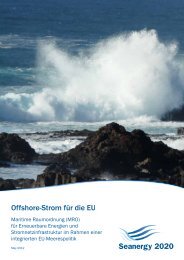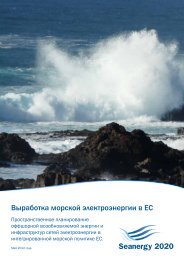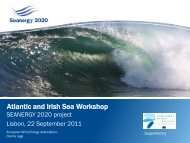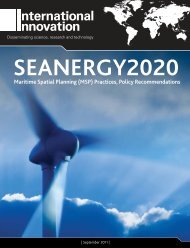Comparative analysis of Maritime Spatial Planning ... - Seanergy 2020
Comparative analysis of Maritime Spatial Planning ... - Seanergy 2020
Comparative analysis of Maritime Spatial Planning ... - Seanergy 2020
You also want an ePaper? Increase the reach of your titles
YUMPU automatically turns print PDFs into web optimized ePapers that Google loves.
• As long as no EEZs are claimed, and with a „beyond <strong>2020</strong>‟ perspective, it would be interesting toexplore the legal possibilities <strong>of</strong> delimitating one or more ORE test zones in the high seas , anarea which constitutes 53 % <strong>of</strong> the Mediterranean maritime space. -This may be an interestingMSP experiment, but should be best discussed at international level (i.e. IMO, FAO) or at seabasin level (EUROMED). Such test MSPs (like the ones that are currently conducted in the BalticSea) or ORE zoning experiments in the high seas may create a perspective to liberate the largepotential <strong>of</strong> ORE zones in the Mediterranean Sea. This possibility will be further analysed in thepart focusing on international MSP instruments and approach,• Any MSP or ORE zoning policy should also take into account the geopolitical significance <strong>of</strong> theMediterranean Sea Basin. The important presence <strong>of</strong> national and NATO naval bases with theirperimeter for military exercises such as fly zones, clearing <strong>of</strong> subsea mines, military explosionzones, is likely to have an impact on the spatial availability for ORE development.3.2. PERMITTING AND LICENSING3.2.1 Barriers and obstaclesThe absence <strong>of</strong> designated zones for <strong>of</strong>fshore wind farms appears to be an important barrier since itleaves the developer with a fundamental basic legal uncertainty in terms <strong>of</strong> appropriate ORE siting.This is illustrated in the Italian licensing process.However, designated ORE zones may be an insufficient condition for sound permitting procedures ifthey are not preceded by a SEA, which seems to be the case in Greece. Specific ORE zones havebeen designated through the Renewables Act <strong>of</strong> 2010, but the outcome <strong>of</strong> the ongoing SEA processfor the specific ORE areas may eventually undo the legal certainty for certain areas.Having a „multi-step‟ approach to licensing may equally discourage ORE development: the permittingand licensing regime in Spain, in spite <strong>of</strong> being soundly rooted in legislation, seems a rather heavyprocess with a minimum <strong>of</strong> five steps, which multiplies the risk <strong>of</strong> refusals during or, worse, at theend <strong>of</strong> the long multi-stage process.The grid connection licensing regime <strong>of</strong>ten constitutes the most decisive barrier for ORE investments.If the possibility to inject the produced electricity is not guaranteed by air-tight legislation orcontractual agreement, investors are likely to go to other ORE markets where the grid connection fornew electricity generation is guaranteed. In Spain no concrete planning studies for enhancing thegrid capacity have been published so far, which may turn out to be the most important barrier in thelicensing process.3.2.2 Good practicesHandling the permitting process through a single procedure for the authorisation to construct on theone hand and a single authorisation procedure for electricity transmission on the other, like in Italy,Deliverable D 2.371 | P a g e






